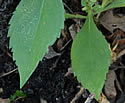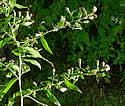Symphyotrichum ontarionis (Ontario Aster)
| Also known as: | Bottomland Aster |
|---|---|
| Genus: | Symphyotrichum |
| Family: | Asteraceae (Aster) |
| Life cycle: | perennial |
| Origin: | native |
| Habitat: | part shade, sun; average to moist soil; floodplains, shores, woods, thickets, meadows |
| Bloom season: | August - October |
| Plant height: | 1 to 4 feet |
| Wetland Indicator Status: | GP: FAC MW: FAC NCNE: FAC |
| MN county distribution (click map to enlarge): |  |
| National distribution (click map to enlarge): |  |
Pick an image for a larger view. See the glossary for icon descriptions.
Detailed Information
Flower: 

![[photo of flowers]](/udata/r9ndp23q/pd/symphyotrichum-ontarionis-7879-2-t.jpg) Branching clusters of short-stalked flowers at the top of the plant and arising from upper leaf axils. Branches are widely spreading to ascending, the clusters loose or more tightly packed. Flowers are 1/3 to ½ inch across with 15 to 25 narrow petals (ray flowers) and a yellow center disk that turns reddish with age. Ray color is white.
Branching clusters of short-stalked flowers at the top of the plant and arising from upper leaf axils. Branches are widely spreading to ascending, the clusters loose or more tightly packed. Flowers are 1/3 to ½ inch across with 15 to 25 narrow petals (ray flowers) and a yellow center disk that turns reddish with age. Ray color is white.
![[photo of bracts (phyllaries)]](/udata/r9ndp23q/white/symphyotrichum-ontarionis-ontario-aster_0929_121745-t.jpg) The bracts (phyllaries) surrounding the base of the flower are in 3 to 6 layers, appressed to slightly spreading, narrow with pointed tips, mostly green, and sparsely covered in short hairs. Flower stalks are up to 1/3 inch long and hairy, with 1 to 5 hairy, leaf-like bracts below the flower.
The bracts (phyllaries) surrounding the base of the flower are in 3 to 6 layers, appressed to slightly spreading, narrow with pointed tips, mostly green, and sparsely covered in short hairs. Flower stalks are up to 1/3 inch long and hairy, with 1 to 5 hairy, leaf-like bracts below the flower.
Leaves and stems: 


![[photo of upper stem leaves]](/udata/r9ndp23q/pd/symphyotrichum-ontarionis-6789-21-t.jpg) Leaves are ½ to 3 inches long, up to 1 inch wide. Basal leaves are generally spatula-shaped with narrowly winged stalks that sheath the stem, leaves becoming egg-shaped on the lower stem and more lance-elliptic in the upper plant. Basal and the lowest stem leaves wither away by flowering time.
Leaves are ½ to 3 inches long, up to 1 inch wide. Basal leaves are generally spatula-shaped with narrowly winged stalks that sheath the stem, leaves becoming egg-shaped on the lower stem and more lance-elliptic in the upper plant. Basal and the lowest stem leaves wither away by flowering time.
![[photo of leaf hairs]](/udata/r9ndp23q/white/symphyotrichum-ontarionis-ontario-aster_1013_191544-t.jpg) The upper leaf surface is rough and variously covered in stiff hairs, the lower surface more densely hairy, especially along the midvein. Edges are coarsely toothed on the lower stem, becoming less toothy as they ascend the stem with the uppermost leaves and bracts toothless or nearly so.
The upper leaf surface is rough and variously covered in stiff hairs, the lower surface more densely hairy, especially along the midvein. Edges are coarsely toothed on the lower stem, becoming less toothy as they ascend the stem with the uppermost leaves and bracts toothless or nearly so.
![[photo of stem hairs]](/udata/r9ndp23q/pd/symphyotrichum-ontarionis-6789-17-t.jpg) Stems are mostly single, ascending to erect, densely short-hairy though may be hairless or nearly so on the lower stem. Plants may form large colonies from creeping rhizomes.
Stems are mostly single, ascending to erect, densely short-hairy though may be hairless or nearly so on the lower stem. Plants may form large colonies from creeping rhizomes.
Fruit: 
![[photo of fruit]](/udata/r9ndp23q/white/symphyotrichum-ontarionis-ontario-aster_1013_190623-t.jpg) Fruit is a dry seed with a tuft of dull white hairs to carry it off in the wind.
Fruit is a dry seed with a tuft of dull white hairs to carry it off in the wind.
Notes:
There are a number of asters with small, white flowers in Minnesota and it can be a real challenge to keep them straight. Ontario Aster is distinguished by a combination of characteristics: smaller than average flower size (½ inch or less) with 15 to 25 rays, flower stalks under ½ inch long, generally lance-elliptic leaves with hairs covering at least the lower surface, and densely hairy stems, at least in the upper plant. By comparison with other white asters having a generally similar leaf shape, Calico Aster (Symphyotrichum lateriflorum) and Awl Aster (S. pilosum) may have similar branching, but Calico Aster flowers have only 9 to 15 rays and a pale disk (not bright yellow), leaves with hairs only along the midvein, and can be clump forming but does not create colonies as Ontario Aster does; Awl Aster flowers are ½ inch or larger, flower stalks may be an inch or more long, phyllaries and bracts have a minute spine at the tip, and stem and leaf hairs are longer. Northern Bog Aster (S. boreale) and Panicled Aster (S. lanceolatum) have larger flowers (½ inch or more) than Ontario Aster, proportionately narrower leaves that are hairless except around the edges, and only lines of hairs on the stems. There are 2 recognized varieties of S. ontarionis: var. glabratum with hairless leaves is present in Michigan and into Canada, and var. ontarionis, with hairy leaves is found in Minnesota and much of the eastern half of North America.
Native Plant Nurseries, Restoration and Landscaping Services ↓
More photos
 Ontario Aster plant
Ontario Aster plant Ontario Aster on a floodplain beach
Ontario Aster on a floodplain beach lower leaves
lower leaves a colony of Ontario Aster
a colony of Ontario Aster upper plant branches
upper plant branches
Photos by K. Chayka and Peter M. Dziuk taken in Ramsey County, and in Wisconsin.
Comments
Have you seen this plant in Minnesota, or have any other comments about it?
on: 2019-09-08 19:07:18
After cycling through the Aster varieties I'm pretty sure what is in my woodland back yard is the Ontario Aster. I've been here 4 years and these are in an area I've not disturbed, other than to dig out a few buckthorn bushes. They have increased in number in a way that seems to follow your description of colonizing.






